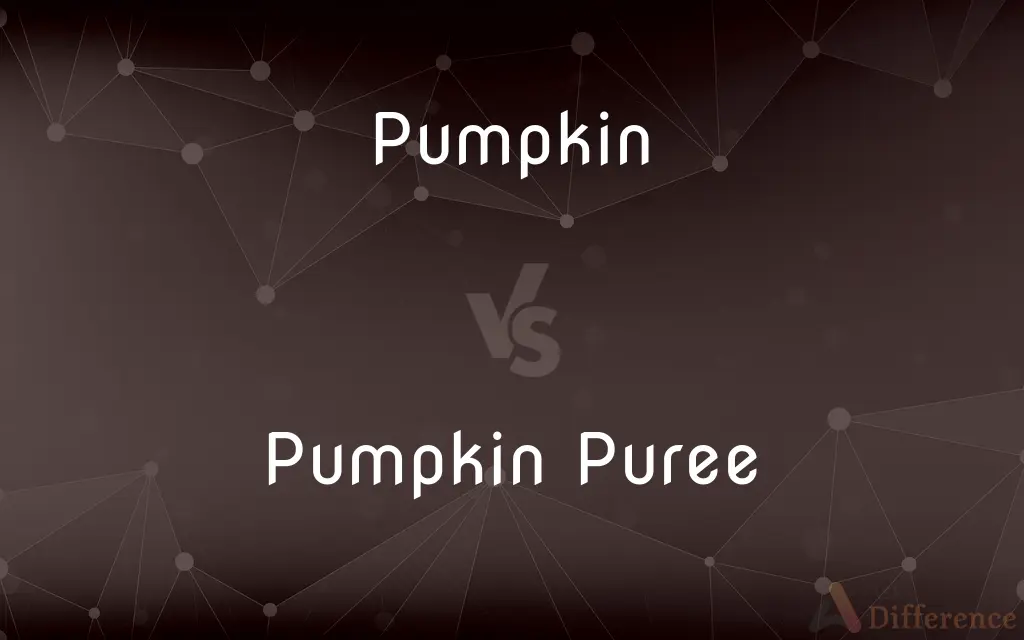Pumpkin vs. Pumpkin Puree — What's the Difference?
By Tayyaba Rehman — Published on November 12, 2023
A pumpkin is a round, orange squash used as a vegetable or for decoration. Pumpkin puree is the mashed or blended flesh of cooked pumpkin. They differ in form, usage, and preparation.

Difference Between Pumpkin and Pumpkin Puree
Table of Contents
ADVERTISEMENT
Key Differences
Nature and Form: A pumpkin is a type of winter squash, commonly orange, and is a cultivar of the squash plant. It's known for its hard shell, seeds, and pulpy center. On the other hand, pumpkin puree is the result when the flesh of a pumpkin is cooked and then mashed or blended into a smooth consistency.
Usage and Application: People use pumpkins for a range of activities, from carving during Halloween to being a primary ingredient in dishes. Pumpkin puree serves as a versatile base for many recipes like pies, soups, and pastries, offering a concentrated pumpkin flavor.
Preparation: While a pumpkin can be baked, boiled, steamed, or roasted, pumpkin puree specifically comes from cooking and mashing the pumpkin's flesh. It's essential to note that pumpkin puree is one of the many ways to process a pumpkin.
Availability: Pumpkins, depending on the region, might be seasonally available, especially during the fall. Pumpkin puree can often be found year-round in grocery stores, either canned or frozen.
Texture and Consistency: The raw pumpkin has a firm and fibrous texture. Once it undergoes the transformation into pumpkin puree, it achieves a soft, smooth consistency, making it ideal for incorporating into various dishes.
ADVERTISEMENT
Comparison Chart
Nature/Form
Raw vegetable/squash
Mashed or blended cooked pumpkin flesh
Common Use
Carving, decoration, cooking
Pies, soups, pastries
Texture
Firm and fibrous
Smooth and soft
Availability
Seasonal (typically fall)
Often available year-round (canned or frozen)
Preparation Method
Can be baked, boiled, steamed, or roasted
Cooked and mashed/blended
Compare with Definitions
Pumpkin
A cultivar of the squash plant.
The pumpkin vine in her garden bore several fruits.
Pumpkin Puree
Free of additives when homemade.
Her homemade pumpkin puree tasted fresh and natural.
Pumpkin
Edible and can be used in various dishes.
She made a delicious pumpkin soup for dinner.
Pumpkin Puree
Smooth consistency ideal for recipes.
The pumpkin puree made the soup creamy and rich.
Pumpkin
Used for decoration during Halloween.
Children excitedly carved faces into their pumpkins.
Pumpkin Puree
Used as a substitute for fats in baking.
By adding pumpkin puree, she reduced the butter in her recipe.
Pumpkin
Contains seeds that can be roasted and consumed.
After cleaning the pumpkin, she roasted its seeds.
Pumpkin Puree
Mashed or blended flesh of cooked pumpkin.
She used pumpkin puree as a base for her pie.
Pumpkin
A round, often large squash with coarse, strongly flavored yellow to orange flesh, numerous seeds, and a moderately hard, usually orange rind.
Pumpkin Puree
Often canned or frozen for extended shelf life.
She stocked up on canned pumpkin puree for the winter.
Pumpkin
Any of several plants producing these fruits, especially varieties of the species Cucurbita pepo, and also varieties of C. maxima and C. moschata.
Pumpkin
A moderate to strong orange.
Pumpkin
A domesticated plant, in species Cucurbita pepo, similar in growth pattern, foliage, flower, and fruit to the squash or melon.
Pumpkin
The round yellow or orange fruit of this plant.
Pumpkin
(uncountable) The color of the fruit of the pumpkin plant.
Pumpkin
(Australia) Any of a number of cultivars from the genus Cucurbita; known in the US as winter squash.
Pumpkin
(US) A term of endearment for someone small and cute.
Pumpkin
A well-known trailing plant (Cucurbita pepo) and its fruit, - used for cooking and for feeding stock; a pompion.
Pumpkin
A coarse vine widely cultivated for its non-keeping large pulpy round orange fruit with firm orange skin and numerous seeds; subspecies of Cucurbita pepo include the summer squashes and a few autumn squashes
Pumpkin
Usually large pulpy deep-yellow round fruit of the squash family maturing in late summer or early autumn
Pumpkin
A round, typically orange squash.
She picked the largest pumpkin from the patch.
Common Curiosities
Can I make my own pumpkin puree?
Absolutely! Cook the pumpkin and then mash or blend the flesh to make puree.
Can I use pumpkin puree in place of oil in recipes?
Yes, pumpkin puree can substitute fats in many baking recipes.
Are all pumpkins edible?
While most pumpkins are edible, some varieties are specifically grown for consumption.
Can I use pumpkin puree for skincare?
Pumpkin puree contains vitamins and can be used in some homemade skincare recipes.
Why is my pumpkin puree watery?
It might have excess moisture; you can strain or cook it down to reduce the water content.
How long does homemade pumpkin puree last?
It typically lasts up to a week in the refrigerator or several months if frozen.
Is canned pumpkin puree as good as fresh?
Canned pumpkin puree is convenient and can be of high quality, but fresh offers a distinct taste.
Can pumpkin puree be used in savory dishes?
Yes, pumpkin puree can be added to soups, sauces, and more.
What is the main difference between pumpkin and pumpkin puree?
A pumpkin is a raw squash, while pumpkin puree is its cooked and mashed flesh.
Are pumpkins only for pies and carving?
No, pumpkins can be used in a wide variety of dishes and crafts.
Can I use pumpkin puree for baby food?
Definitely! Ensure it's plain puree without additives.
How do I choose a good pumpkin for puree?
Opt for sugar or pie pumpkins; they're denser and sweeter.
Is there a difference in taste between canned and fresh puree?
Fresh puree can have a brighter, more distinct pumpkin flavor, while canned might be milder.
Are pumpkins and pumpkin puree nutritious?
Yes, both are rich in vitamins, especially vitamin A, and other nutrients.
Is pumpkin puree the same as pumpkin pie filling?
No, pumpkin pie filling contains spices and sweeteners, while puree is just mashed pumpkin.
Share Your Discovery

Previous Comparison
Reckless vs. Impulsive
Next Comparison
Spam Mail vs. Junk MailAuthor Spotlight
Written by
Tayyaba RehmanTayyaba Rehman is a distinguished writer, currently serving as a primary contributor to askdifference.com. As a researcher in semantics and etymology, Tayyaba's passion for the complexity of languages and their distinctions has found a perfect home on the platform. Tayyaba delves into the intricacies of language, distinguishing between commonly confused words and phrases, thereby providing clarity for readers worldwide.












































